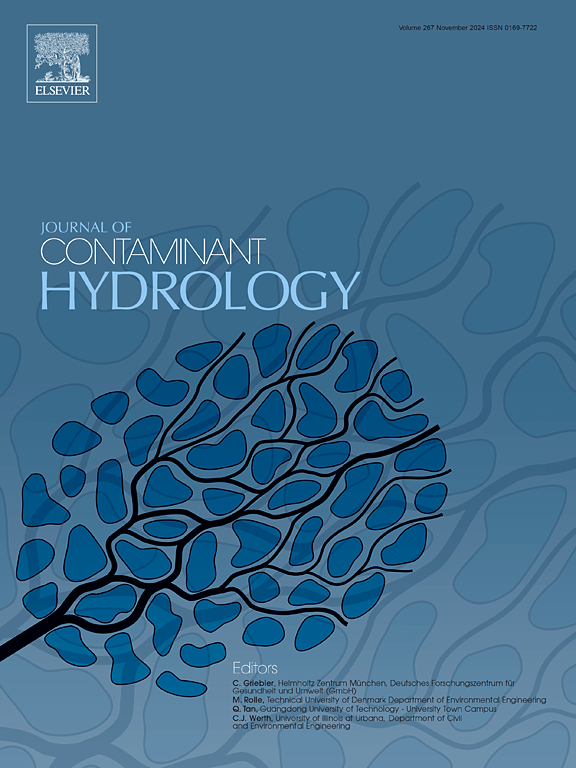Groundwater quality drivers in the drought-prone Thakurgaon District, Northwestern Bangladesh: An integrated fuzzy logic and statistical modeling approach
IF 3.5
3区 环境科学与生态学
Q2 ENVIRONMENTAL SCIENCES
引用次数: 0
Abstract
Groundwater quality in the drought-prone Thakurgaon District, Northwestern Bangladesh, is deteriorating due to a combination of natural and anthropogenic factors. This study evaluates the key drivers of groundwater quality degradation by employing ecotoxicological risk indices, such as the Heavy Metal Pollution Index (HPI), Heavy Metal Evaluation Index (HEI), and Nemerow's Pollution Index (NPI). An innovative fuzzy logic approach is used to integrate these indices and reduce uncertainty, while Automatic Linear Modeling (ALM) predicts the primary impacts on the Fuzzy Groundwater Quality Index (FGWQI). Additionally, Monte Carlo simulations assess probabilistic health risks and sensitivity. Groundwater samples from 40 wells were analyzed for physicochemical parameters and heavy metal concentrations. The results show that 25 % of the samples are unsuitable for drinking, and 17.5 % are unfit for household use, based on HPI and HEI values. Fuzzy analysis reveals that 22.5 %, 47.5 %, and 30 % of the samples exhibit excellent, good, and poor quality, respectively. The overlay of FGWQI with Land Use/Land Cover (LULC) maps identifies areas with excellent groundwater quality in the southern parts of the region, while the northern areas suffer from poor quality due to overexploitation. One-way ANOVA indicates that rainfall, water discharge, and LULC significantly affect FGWQI. The ALM results highlight HEI (0.62) and HPI (0.38) as the main factors influencing FGWQI. Health risk analysis reveals elevated non-carcinogenic risks due to arsenic and lead ingestion, particularly for children. These findings emphasize the need for targeted policies and interventions to mitigate health risks and ensure the well-being of the community.
孟加拉国西北部易干旱的Thakurgaon地区的地下水质量驱动因素:一种综合模糊逻辑和统计建模方法
在孟加拉国西北部易干旱的Thakurgaon地区,由于自然和人为因素的综合作用,地下水质量正在恶化。本研究采用重金属污染指数(HPI)、重金属评价指数(HEI)和Nemerow污染指数(NPI)等生态毒理学风险指标评价地下水水质退化的关键驱动因素。采用一种创新的模糊逻辑方法对这些指标进行综合,降低不确定性,而自动线性建模(ALM)预测对模糊地下水质量指数(FGWQI)的主要影响。此外,蒙特卡罗模拟评估概率健康风险和敏感性。对40口井的地下水样品进行了理化参数和重金属浓度分析。结果表明,根据HPI和HEI值,25%的样品不适合饮用,17.5%的样品不适合家庭使用。模糊分析结果显示,22.5%、47.5%和30%的样品质量为优、良和差。FGWQI与土地利用/土地覆盖(LULC)地图叠加,确定了该地区南部地下水质量优良的地区,而北部地区由于过度开采而水质较差。单因素方差分析表明,降雨量、水量和LULC显著影响FGWQI。ALM结果显示HEI(0.62)和HPI(0.38)是影响FGWQI的主要因素。健康风险分析显示,砷和铅的摄入增加了非致癌风险,特别是对儿童而言。这些调查结果强调需要有针对性的政策和干预措施,以减轻健康风险并确保社区的福祉。
本文章由计算机程序翻译,如有差异,请以英文原文为准。
求助全文
约1分钟内获得全文
求助全文
来源期刊

Journal of contaminant hydrology
环境科学-地球科学综合
CiteScore
6.80
自引率
2.80%
发文量
129
审稿时长
68 days
期刊介绍:
The Journal of Contaminant Hydrology is an international journal publishing scientific articles pertaining to the contamination of subsurface water resources. Emphasis is placed on investigations of the physical, chemical, and biological processes influencing the behavior and fate of organic and inorganic contaminants in the unsaturated (vadose) and saturated (groundwater) zones, as well as at groundwater-surface water interfaces. The ecological impacts of contaminants transported both from and to aquifers are of interest. Articles on contamination of surface water only, without a link to groundwater, are out of the scope. Broad latitude is allowed in identifying contaminants of interest, and include legacy and emerging pollutants, nutrients, nanoparticles, pathogenic microorganisms (e.g., bacteria, viruses, protozoa), microplastics, and various constituents associated with energy production (e.g., methane, carbon dioxide, hydrogen sulfide).
The journal''s scope embraces a wide range of topics including: experimental investigations of contaminant sorption, diffusion, transformation, volatilization and transport in the surface and subsurface; characterization of soil and aquifer properties only as they influence contaminant behavior; development and testing of mathematical models of contaminant behaviour; innovative techniques for restoration of contaminated sites; development of new tools or techniques for monitoring the extent of soil and groundwater contamination; transformation of contaminants in the hyporheic zone; effects of contaminants traversing the hyporheic zone on surface water and groundwater ecosystems; subsurface carbon sequestration and/or turnover; and migration of fluids associated with energy production into groundwater.
 求助内容:
求助内容: 应助结果提醒方式:
应助结果提醒方式:


